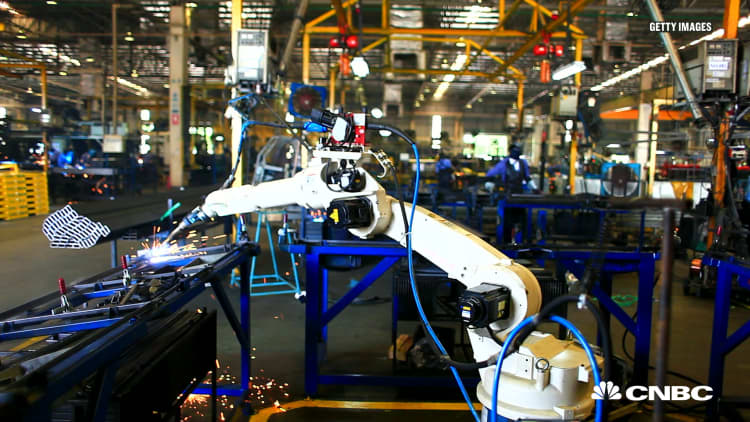On the stump in 2016, both candidates talked about creating jobs, taxes, the economy, and trade. But what neither talked about was perhaps the greatest threat to economic security in the future: automation and computerization.
Take, for example, the number one job held by men today: Nearly 3 million of them are truck drivers. What will happen to them in a decade when Daimler expects its self-driving 18-wheeler now being tested in the Nevada desert to be ready for the road? How about the top job among women, that of administrative assistant? Technology already has wiped away many of those positions in companies large and small.
And it's not just popular low-skilled jobs that artificial intelligence threatens. A 2013 study from Oxford University predicts that future technology could displace nearly half of American jobs. History has shown such predictions to be wildly exaggerated, of course. In the long race between education and technology, education typically wins.
But past performance might not be indicative of future results in this next wave of automation, and even those with higher skilled jobs might not be safe. Even jobs in finance, law, and medicine don't offer the steady career paths they once did.
More from Jeffrey Selingo:
Big Idea 2017: The Rethinking of Credentials
The job nobody can seem to keep: college president
How Being from a Privileged Background Helps Men, but Not Women, Land Top Jobs

The question that politicians should be discussing now is what kind of education is needed to stay ahead of automation, or more likely, to complement technology. Previous changes in the nature of work all required massive policy shifts in education. Universal high school started at the beginning of the 19th Century in the move from the farm to the factory. The move from the factory to the office in the 1960s and 1970s required education after high school and began the universal college movement.
But higher education attainment in the U.S. has essentially leveled off during the past few decades. Even as more students have attempted college, not all are finishing. What's needed from the major presidential candidates is not just promises of making college more affordable, but a menu of policies that better align higher education with the workforce of the 21st Century.
A strategy to fill 'middle-skills jobs'
First, a strategy is needed to fill so-called "middle-skills jobs." These are positions that in previous generations would have been filled by high-school graduates, but today require more than a high-school diploma but less than a four-year degree. They include jobs in advanced manufacturing, health care, and information technology.
Nearly half of the American workforce has these jobs today, but many of them are filled by aging Baby Boomers who soon will be retiring. It's expected that as many as 25 million new job openings in the next decade will be for middle-skills jobs.
In a 2014 survey, Accenture found that 69 percent of human-resources executives said that middle-skill talent shortages "regularly affect their performance."
Unfortunately, too many high-school students who could take these jobs are discouraged from pursuing apprenticeships or community college degrees. Instead, parents and counselors encourage them to follow the well-plotted and well-trod course to a four-year college.
But only about half of students who start at a four-year institution finish with a bachelor's degree. There are 12.5 million adults who leave college short of a degree, according to the National Student Clearinghouse.

Education for fifth job, not just first
Another key reform to make higher education relevant for the 21st century workforce is to ensure that colleges and universities are not just training students, but educating them.
Many colleges are chasing the latest and hottest career fields by creating new majors and programs narrowly tailored to get students a job right out of college. But in doing so, they are often paring back the liberal arts that supply students with the problem-solving abilities and communication skills critical to the workforce of the future.
Instead, our entire education system from primary school through college seems so focused on teaching skills that will be automated in the future. The jobs that are growing the most are those that require high social skills as well as analytical skills, according to David Deming, an associate professor of education and economics at Harvard University.
When high-school and college were first deemed necessary to succeed in the American economy, a one-size-fits-all approach to preparing for the workforce seemed adequate. But today, in a global, information economy, we need an education system with multiple pathways and approaches to ensure employment opportunities for workers at all skill levels and with varied backgrounds.
Jeffrey Selingo is author of the new book, There Is Life After College. You can follow his writing here, on Twitter @jselingo, on Facebook, and sign up for free newsletters about the future of higher education at jeffselingo.com.
He is a regular contributor to the Washington Post's Grade Point blog, a professor of practice at Arizona State University, and a visiting scholar at Georgia Tech's Center for 21st Century Universities.

